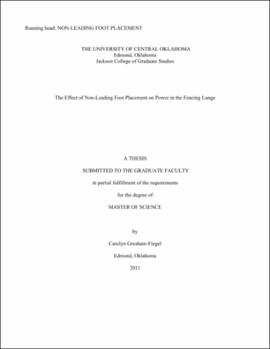| dc.contributor.advisor | House, Paul | |
| dc.contributor.author | Gresham-Fiegel, Carolyn | |
| dc.date.accessioned | 2020-05-26T20:37:36Z | |
| dc.date.available | 2020-05-26T20:37:36Z | |
| dc.date.issued | 2011 | |
| dc.identifier.other | (AlmaMMSId)9978545185202196 | |
| dc.identifier.uri | https://hdl.handle.net/11244/324674 | |
| dc.description.abstract | Fencing success does not depend on specific morphological or physiological attributes. Nevertheless, the muscular demands are very specific and development of effective movement takes time and practice. Being able to lunge appropriately and with adequate power is an essential ability for fencers. But while the pattern of muscular activation is known, the effect of foot placement has not been investigated. Using a TENDO weightlifting analyzer to assess velocity and power, the impact of foot placement angle on lunge power is studied. | |
| dc.rights | All rights reserved by the author, who has granted UCO Chambers Library the non-exclusive right to share this material in its online repositories. Contact UCO Chambers Library's Digital Initiatives Working Group at diwg@uco.edu for the permission policy on the use, reproduction or distribution of this material. | |
| dc.subject.lcsh | Fencing | |
| dc.subject.lcsh | Fencing | |
| dc.title | The effect of non-leading foot placement on power in the fencing lunge. | |
| dc.type | Academic theses | |
| dc.contributor.committeeMember | Cobb, Donna | |
| dc.contributor.committeeMember | Lucas, Larry | |
| dc.thesis.degree | M.S., Kinesiology and Health Studies | |
| dc.identifier.oclc | (OCoLC)ocn840683569 | |
| uco.group | UCO - Graduate Works and Theses::UCO - Theses | |
| thesis.degree.grantor | Jackson College of Graduate Studies | |
